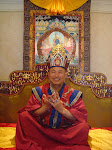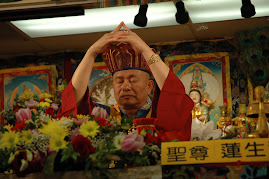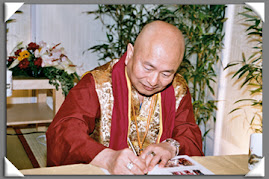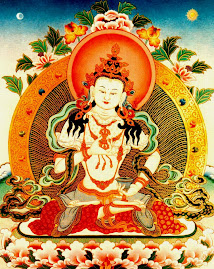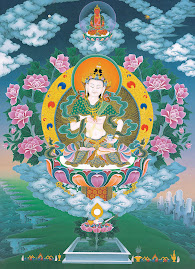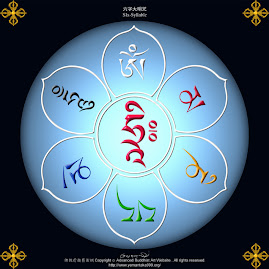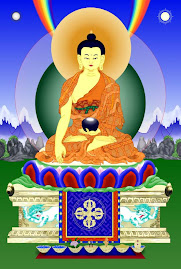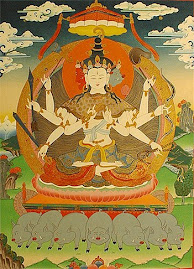Next is the step of invocation. I will tell you some of the very important secrets I have learned. In general, one joins the palms and recites "
Invocation by Mind
In Tantric practice, invocation is accompanied by mudra, mantra, and visualization. We join our palms while we recite the Invocation Mantra. While the palms are joined, one visualizes the heart charka open up to transform into a lotus. On the lotus is a moon disc bearing the seed syllable of the Personal Deity on which one is meditating. If the deity is Amitabha, then the seed syllable is "hri". The seed syllable emits three beams of light in the color that corresponds to the particular deity. In the case of Amitabha, the color is red. These three beams of red light then travel through the middle channel of the body and leave the crown to shine into the Empty Space above. This projection of the red light three times into the spiritual realm is an invocation by mind or visualization. While one is invoking the deities by speech, i.e. by chanting three times "
Invocation by Speech
We recite "
Invocation by mind or visualization is an extremely powerful method. It is an integral part of Tantric cultivation. When one very clearly visualizes the heart chakra opening to form the lotus, moon disc, seed syllable, and the radiating of the light beams three times, the Buddhas and Bodhisattvas will definitely descend.
Invocation by Mudra
Vajra Hook Mudra
There are many subtleties in the practice of Tantra and these subtleties are what I am explaining in detail today. Although it begins as visualization, a kind of ritual, it will manifest into a reality. When one recites "Namo Vajra Hook Bodhisattva Mahasattva" three times and raises the hook up into the Empty Space to hook onto the cloud throne of the Buddha or Bodhisattva and pull it down, the deity will descend from above. This is the secret.
Many people have written to ask me this question, "Grand Master, how do I know whether the Buddhas and Bodhisattvas I invoke each time have, indeed, descended or not?" One is finished if one does not know whether or not the divine beings come each time one does the practice! Where I one's mind at the time of invocation? When one invokes the Buddhas, Bodhisattvas, and other deities, of course they will come. If they don't come, it is because one has not put the mind totally into it. Invocations accompanied by mantra, mudra, and visualization are extremely subtle and effective. Today I am disclosing all the secrets and skills I have learned because I hope that every single one of my 1.2 million students can become a Buddha. I am disclosing all this so that there will not be cases where students do not have any spiritual experiences after several years of practice and, therefore, lose interest and the desire to do cultivation. I don't want people to waste those thirty, forty, or sixty minutes in the shrine by napping or hiding inside as if the shrine were a bomb shelter.
One has to treat one's practice seriously, with real attention. To practice inside the Tantric shrine is to be in complete Oneness with the Universal Consciousness. By achieving
That is why this teaching of invocation is very important. One has to know that it is not enough just to employ a hook to pull the Buddha down; one has to make the Buddha enter oneself. Even that is not enough; one has to transmute and become the Buddha. This is what Tantra and "spiritual response" is all about. When one practices the Guru Yoga or Personal Deity Yoga, one has to transmute and become indivisible with the Guru or the Personal Deity.
Visualization of Movement
Signs of the Descent of Buddhas and Bodhisattvas
When I invoke the divine beings and offer them my meals, I join my palms and recite, "Please enjoy the meal, Amitabha Buddha, Kuan Yin Bodhisattva, and Mahasthamaprata Bodhisattva." This might seem very casual, but I know whether they come or not. I don just casually call upon them and start eating whether or not they have descended. Sometimes they don't come. Why? Because sometimes the food looks so delicious that I start eating right away and forget about making offering to them until I have put the food into my mouth. When I remember, I clap my hands and invoke them to come. Well, they won't come then. Sometimes I feel quite embarrassed, and if Mrs. Lu happens to walk by with a fresh plate of food that is untouched, I will borrow it to make an invocation and offering, and then they will come.
So, one should be able to tell whether the divine beings come or not. If today I were unable to tell if they come or not, and I sit here and tell you that I know, that would be fibbing. Any moment during the process of meditation, I can tell if the Buddhas and Bodhisattvas are bestowing blessing or empowerment. I am sitting in front of the Buddhas and Bodhisattvas now. If I say I know and the Buddhas behind me contradict me, then I would be lying. Every day during meditation, while one is sitting in front of the shrine, a true cultivator should be able to tell if the Buddhas are giving one empowerment or blessing, if they are patting one's head and emitting light on one, or cleansing one's body and mind with Great Compassion Dharani Water. It is a very real, strong and firm sensation. It is definitely not a vague feeling. If one is uncertain, then it is because one mind is not completely in it!
As I said, it is a very real and definite sensation. Either one feels it or one does not. It is a kind of contact, a kind of touch that can be clearly felt - definitely not something vague. Now I find spiritual cultivation to be very wonderful. Why? My body feels very light and I feel very peaceful. This lightness differs from the lightness of weight loss that one experiences when one has had an upset stomach and has not been eating properly. This peacefulness is not a result of taking a nap inside the shrine. It is entirely different in nature.
So the step of invocation is very important. Its secret lies in the moving of the deity: his "chi" moving, his limbs moving, his toes moving, his celestial garment moving, and his eyes moving. The he will descend.
Invocation at Times of Urgency
Why have I not explained these invocation secrets in such detail before in my books? Because many students are unable to learn and do so much right away. If I had taught everything at the beginning, it would take students almost half an hour just to do the invocation alone! The fact is, I hope that, after everyone became familiar with the steps in doing the practice, I would explain the additional important points and ideas, one at a time, so that everyone would have a clear understanding of them. If I had not begun with a streamlined version, many people would have found the practice too long to attempt. Even though they might be attracted to it, they would be reluctant to spend time doing it and would have given up. That was why I had simplified the first two steps of the chanting of Purification Mantras and the Invocation Mantra. I was waiting for people to progress to the point where they were ready to go into deeper levels of practice before presenting them with more detailed instructions. After one understands this, one can slowly incorporate all the details into one's practice and gradually enter into the deeper levels. If one has been doing cultivation for some time, by learning these secrets now, one level of practice will be deepened. Does everyone now understand how to do the invocation? This is a very important step.
The Vajrasattva Invocation Mantra
Why is the Vajrasattva Mantra also used for invocation? One knows that the Primordial Buddha - Adi Buddha - is also called the Principal Vajradhara and resides at the Sixteenth Stage. Exoteric schools generally only mention gradations up to the Tenth Stage. Adi Buddha is from the Sixteenth Stage. The Five Dhyani Buddhas are also known as the Five Vajradharas. Vajrasattva, being formed from the combination of the Five Vajradharas, is called the Sixth Vajradhara. This is why the mantra of Vajrasattva can be used for invocation and is just as great as the invocation mantra of the Five Dhyani Buddhas. These mantras can be traced to their source. Therefore, one first has to learn that Adi Buddha is the Primordial Buddha, or Samantabhadra Buddha. In Vajrayana, he is called the Principal Vajradhara. The Five Dhyani Buddhas are the Five Vajradharas and Vajrasattva is the Sixth Vajradhara.
The suffix "sattva" comes from Bodhisattva, Kuan Yin, Cundi, and Padmasambhava are Bodhisattvas. The lineage of Vajrayana is traced to Vajrasattva because it was from Vajrasattva that Nagarjuna Bodhisattva had received the Vajrayana teachings after unlocking the









